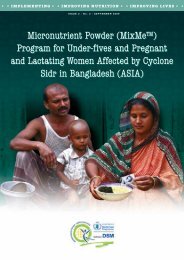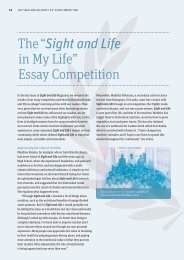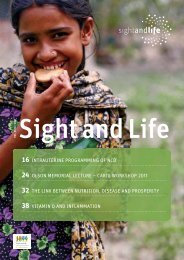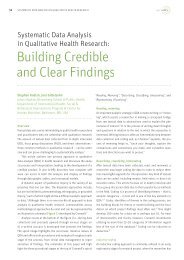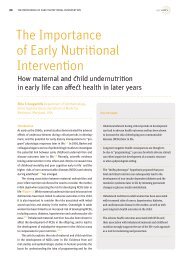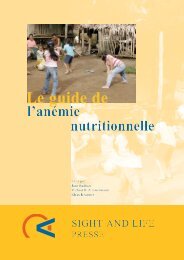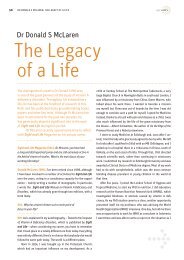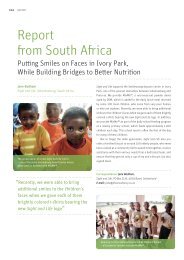Sight and Life Magazine 1/2011
Sight and Life Magazine 1/2011
Sight and Life Magazine 1/2011
You also want an ePaper? Increase the reach of your titles
YUMPU automatically turns print PDFs into web optimized ePapers that Google loves.
30THE FEASIBILITY OF DELIVERING VITAMIN A TO NEWBORNSTesting the Feasibilityof Delivering Vitamin Ato Newborns in Nepal<strong>and</strong> BangladeshRolf DW KlemmCenter for Human Nutrition, Bloomberg, School ofPublic Health, Johns Hopkins University <strong>and</strong> A2Z:The USAID Micronutrient <strong>and</strong> Child Blindness ProjectRaj Kumar Pokharel, R P BichhaMinistry of Health <strong>and</strong> Population, NepalBackgroundInfants are born with small livers <strong>and</strong> total body stores of vitaminA (VA). 1–5 Exclusively breastfed infants depend on adequatebreastfeeding <strong>and</strong> good health to build body stores. 6However, low breast milk vitamin A, inadequate breast milk intakeconcentration, 5–8 poor complementary food quality 9 <strong>and</strong>/orfrequent infection 10 can all reduce an infant’s ability to achievenormal vitamin A status.Makhduma NargisRevitalization of Community Health CareInitiative/Community Clinic, Ministry of Health <strong>and</strong>Family Welfare, BangladeshZeba MahmudMicronutrient Initiative, BangladeshLesley OotA2Z: The USAID Micronutrient <strong>and</strong> Child BlindnessProject, AED, Washington, DC, USAPankaj Mehta, Naveen Paudyal UNICEF, NepalJaganath Sharma NFHP II/USAID, NepalM R Maharjan, Neera SharmaMicronutrient Initiative, NepalMahbubur Rashid The JiVitA Project,Gaidb<strong>and</strong>ha, BangladeshA promising new interventionNewborn vitamin A supplementation (NVAS) is a promising newintervention that involves supplementing infants shortly afterbirth with a single, large oral dose of vitamin A (50,000 IU)(Figure 1). The intervention was tested in three field trials insouthern Asia (Indonesia, India, <strong>and</strong> Bangladesh), each of whichreported significant reductions of ≥ 15% in infant mortality inthe first six months of life. 11–13 When combined, the resultssuggest that infant mortality can be reduced by approximately20% in southern Asia by giving newborns a single, oral dose ofvitamin A. 14 Given previous evidence of safety with respect toshort- or long-term side effects, 15–20 newborn vitamin A supplementationappears to be a low-cost approach to reducing infantmortality in South <strong>and</strong> Southeast Asia.In Africa, however, this intervention had no beneficial effecton early infant survival in an urban setting in Zimbabwe, 21 <strong>and</strong>a peri-urban setting in Guinea Bissau. 22,23 All three African studies(two in Guinea Bissau) were done in populations with little,if any, vitamin A deficiency. Mortality in the Zimbabwean studywas very low. 21 In one study in Guinea Bissau, investigatorsreduced mortality by excluding the highest risk infants (thosewith low birth weight) <strong>and</strong> giving free care <strong>and</strong> drugs to sickinfants. 22A 2008 WHO Technical Consultation on Neonatal Vitamin ASupplementation Research Priorities 24 made the following



